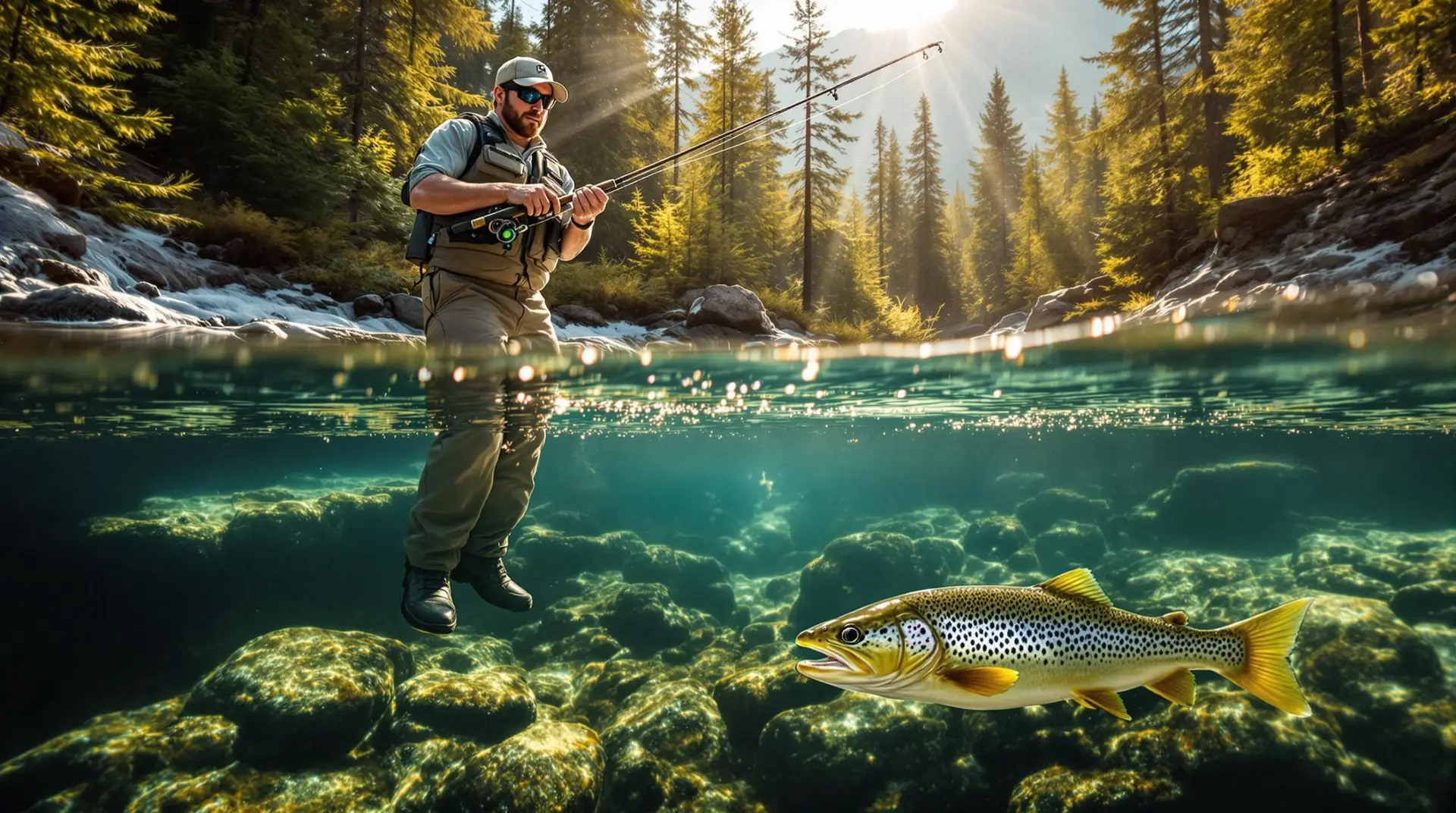Understanding Short Line Nymphing
Short line nymphing is a precise fly fishing trick that’s all about control. It means tossing a short line upstream or sideways, fiddling with the line to keep your fly floating just right, and spotting those sneaky strikes by watching the leader.
Introduction to Short Line Nymphing
Short line nymphing is like the ninja move of Euro nymphing, letting fishers plop their flies down right where they want them. You chuck a short line upstream or across the stream, and you steer the drift by tinkering with the line. This keeps the flies hanging around where trout like to munch, giving them an offer they can’t refuse. Keeping a keen eye on the leader for any sneaky tugs is the name of the game here (Manic Tackle Project).
| Aspect | Description |
|---|---|
| Casting Direction | Upstream or across stream |
| Line Control | Constant line mending |
| Strike Detection | Watch leader like a hawk |
| Presentation | Natural, precise, no drag |
Want to learn more about casting like a pro? Check our guide on how to euro nymph.
Benefits of Short Line Nymphing
The perks of short line nymphing are plentiful, especially for those chasing trout in zippy runs and steady pools. It lets you take charge of the line, making sure it drifts drag-free, boosting the odds of hitting the jackpot.
Key Benefits
- Master Line Control: You keep the line on a tight leash, making spot-on tweaks.
- Keeps It Real: The fly drifts naturally, giving trout a genuine treat.
- Rocks in Rapid Water: A winner in fast runs and calm pools where dropping flies to the bottom is gold (Troutbitten).
- Catch the Bite: Spotting tiny hints of a bite means you’re ready to reel them in fast.
| Benefit | Advantage |
|---|---|
| Better Line Control | Precise tweaks and changes |
| Natural Drifts | Real-deal drift, tempting trout |
| Solid in Fast Water | Key to bottom fishing success |
| Quick Strike Detection | Fast and sure hook-ups |
Ready to squeeze every drop of this technique’s benefit? Dive into our piece on advanced euro nymphing.
Using these tricks well can skyrocket your catch rates. To dig deeper into nymphing wizardry, check out our in-depth articles on contact nymphing technique and nymph drift mechanics to sharpen your skills more.
Techniques in Short Line Nymphing
Short line nymphing gives fly fishing pros a couple of cool tricks: the Floating Line and Extended Leader System, and the String Technique that’s all about ditching the Fly Line. Each one brings its own flair for better line control and making a splash in fast and steady waters.
Floating Line and Extended Leader System
The Floating Line paired with a long leader is like your trusty sidekick in short line nymphing. Picture it: a floating fly line teamed up with a super-long, low-stretch monofilament leader.
Here’s the deal with the floating line:
- Line Control: It lets you keep a piece of the fly line on the water, so you’re the boss of the drift and can tweak things as you go.
- Visibility: You won’t lose sight of it; just watch those strikes!
- Flexibility: This setup is like a Swiss Army knife—you can switch from nymphing to dry fly fishing without fussing with new gear.
The secret sauce often includes a ten-foot rod with a weight of two or four, perfect for snatching up more line and dancing it around the water. The leader is set long, with droppers that often do a neat three-fly shuffle. Flies here go slim, heavy, and ready to deep dive.
| Component | Specification |
|---|---|
| Rod Length | 10 feet |
| Rod Weight | 2-4 |
| Leader Length | Extended (e.g., 15-20 feet) |
| Fly Setup | Traditional droppers, 3-fly setup |
| Fly Type | Slim and well-weighted |
Curious about cracking the nymphing code? Check out our guide on nymphing leader setup for some pro tips.
String Technique without Fly Line
The String Technique gets a nod from Czech and Kiwi champs at the World Championships, running a long monofilament leader straight to the reel—no fly line needed (Manic Tackle Project).
What’s the big whoop about the String Technique?
- Sensitivity: With no fly line, there’s less stretch between you and the fish, so you feel every nibble.
- Control: The long monofilament leader gives you Jedi-like control over where the fly goes and how it drifts.
- Simplified Rig: A lighter, more responsive setup that reacts to the tiniest flicks.
This style shines when precise control matters, like in fast sticks and smooth streams. Gear up like the Floating Line, but keep the leaders non-stretch and the flies chunky and heavy.
| Component | Specification |
|---|---|
| Rod Length | 10 feet |
| Rod Weight | 2-4 |
| Leader Type | Long monofilament |
| Leader Length | Extended (e.g., 20-30 feet) |
| Fly Setup | Traditional droppers, 3-fly setup |
| Fly Type | Slim and well-weighted |
Wanna dive into more advanced nymphing tricks? Check our page on advanced euro nymphing.
Each nymphing method brings its own perk: choose the Floating Line setup for its versatility or go with the String Technique for keen sensitivity and control. For more noodling in nymphing waters, our resources on contact nymphing technique and technical nymph fishing are packed with know-how.
Setup for Short Line Nymphing
Getting your gear right is like tying your best fly—you gotta hit the sweet spot! Let’s jump into what makes a killer setup for short line nymphing, especially Czech style. We’re talking rods, weights, leader materials, and fly setups.
Rods and Weights for Czech Nymphing
Czech nymphing is all about going long—but not that kind of long! Those ten-foot rods in weights two, three, or four are your new best friends. Why? They help keep your line above water, keeping you connected with those sneaky nymphs doing their thing below.
| Rod Length | Rod Weight | What’s It Good For? |
|---|---|---|
| 10-foot | 2-4 weight | Keeping line off water, breeze through tricky spots for killer precision. |
These longer rods give you superpowers—kinda like Spider-Man’s web slinging—getting you precision and control in those tough waters. And don’t forget, accuracy in your drifts can mean the difference between “fish on!” or getting skunked. Check out more on keeping your short line game strong with tips in our advanced euro nymphing section.
Leader Materials and Fly Setup
Now, let’s talk about shooting the breeze with leader materials and fly setup. Picking the right gear here is like having soft butter on your morning toast. Some anglers swear by low-stretch monofilament leaders or those non-stretch fly lines for the magic touch.
A typical setup looks something like a traditional dropper just flaunting a three-fly parade. This rig helps those flies sink like a pro and drift like a leaf on a stream. And the flies? Keep ’em slim and weighty, so they dance right through the water layers.
| Setup Components | What’s the Deal? |
|---|---|
| Leader Material | Low-stretch monofilament, because who likes stretch anyway? |
| Fly Configuration | Traditional droppers with a triple threat––because three’s a charm. |
| Fly Characteristics | Slim and serious, with a bit of weight to show they mean business. |
For getting into the nitty-gritty details on leaders and flies, we’ve got more deets in our nymphing leader setup guide.
Getting short line nymphing down to an art doesn’t stop at getting tangled in technique. Gear up right, whether you’re poking around the high stick nymphing path or tweaking your nymph rig weight placement. Fine-tuning your gear is half the fun. Just think of it like charging up your game to reach that next level—fish on, my friends!
Application of Short Line Nymphing
Fishing Fast Runs and Constant Pools
Got a river with fast flows or steady pools? Short line nymphing is your secret weapon. By taking charge of your line, you’ll get those nymphs drifting like naturals, right into the fish’s favorite hideouts. Picture positioning yourself perfectly above where the fish hang out—your nymphs just do the waltz right through their living room.
| Water Structure | Handy Techniques | Perks |
|---|---|---|
| Fast Runs | Spot-on positioning and drift handling | Smooth drifts, no drag slowing you down |
| Constant Pools | Keen depth control | Easier bottom contact, more fish nibbles |
Here, keeping those flies hugging the bottom really seals the deal. Trying out tricks like the string technique—which skips the fly line—keeps your fishing precise and on point. Want even more tricks? Dig into nymph drift how-tos and current seam nymphing strategies.
Origin and Evolution of Short Line Nymphing
Here’s some backstory for you: Short line nymphing, often called Czech Nymphing, got a big boost after the 1984 World Championships. The Czechoslovakian team worked their magic with limited fly line, showing off a method that turned heads instantly (Manic Tackle Project).
The roots of this nymphing style extend back to Charles Brooks’ 1976 book “Nymph Fishing for Larger Trout.” He rolled out techniques like the Leisenring lift and high-sticking—stuff that’s bread-and-butter for any short line nymphing enthusiast these days. The Czechs eventually honed and evolved this art further.
Lately, the string technique—favored by the Czech and Kiwi teams in championship wins—employs a simple monofilament leader stretching back to the reel, reshaping competitive results (Manic Tackle Project).
| Year | Happening | Why It Matters |
|---|---|---|
| 1976 | “Nymph Fishing for Larger Trout” hits bookshelves | Lays down the nymphing basics |
| 1984 | The championship year | Czechoslovakian prowess takes the spotlight |
| Recent | More wins at World Championships | Czech and Kiwi lead with string technique triumphs |
Craving more historical nymph wisdom? Check out technical nymph know-how and competition nymphing insights.
When done right, these short line techniques can turn ace fishers into legends, transforming results in the trickiest parts of the water. Want more tips? Dive into our guides on elevated euro nymphing and tight contact nymphing tactics.

